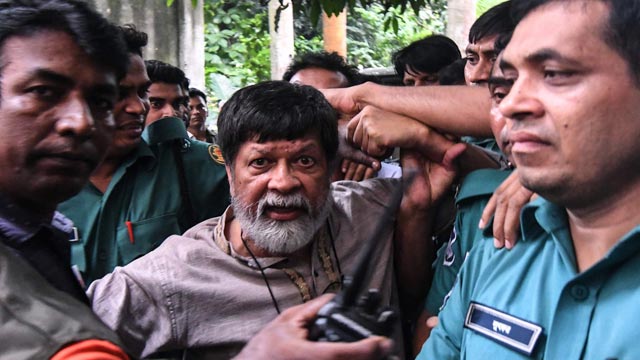New York, Aug 19 (Just News): Shahidul Alam used his photography to challenge the Bangladeshi government and military on freedom of speech issues and the “disappearances” of their political opponents.
US based prestigious newspaper the New York Times wrote an editorial about the recent attack on freedom of expression by the ruling authority of Bangladesh.
“Shahidul Alam: A Singular Voice in Photography for Dignity and Human Rights” title it says “Shahidul Alam grimaced as he staggered on his way into a Dhaka courthouse on Aug. 6. Handcuffed and surrounded by the police, he loudly proclaimed he had been tortured after more than 30 plainclothes officers snatched him from his home the night before.”
“Mr. Alam, an internationally known photographer, educator and human rights advocate, was detained shortly after giving an interview to Al Jazeera and posting a series of live videos on Facebook that criticized the government’s violent response to two weeks of student-led protests that began over road safety. Many photojournalists covering the protests, including Mr. Alam, have been attacked by the police and armed gangs linked to the ruling Awami League party.”
It said, “He has now been charged under Section 57 of Bangladesh’s Information Communications Technology Act, which lets the authorities arrest people who criticize the government online. He remains in jail at least until Sept. 11, when he will have a hearing on a bail request that was filed this week.”
The editorial wrote, “Human rights organizations, as well as journalism and photography groups, have loudly protested his imprisonment. The Committee to Protect Journalists called on Bangladeshi authorities “to immediately halt widespread attacks on journalists covering ongoing student protests in Dhaka and to release photographer Shahidul Alam from jail.” Omar Waraich, Amnesty International’s deputy director for South Asia, demanded his immediate and unconditional release. “There is no justification whatsoever for detaining anyone for solely peacefully expressing their views,” he said.”
“Over three decades photographing in Bangladesh, Mr. Alam has covered major events, natural disasters, governmental upheavals, the deaths of thousands of garment factory workers and the struggle against human rights abuses. He has also used his photography to challenge the Bangladeshi government and military on freedom of speech issues and the “disappearances” of their political opponents.”
The editorial further added, “But, just as important, he has helped to produce generations of Bangladeshi documentarians, and also built the infrastructure for them to tell their own stories. For 30 years, his Pathshala South Asian Media Institute has trained scores of talented photographers and helped Bangladesh gain a reputation for its vibrant photo community. The Chobi Mela photo festival, which he started in 1999, brings photographers from around the world to Dhaka, the capital. The Drik Photo Agency, which he started in 1989, sells stories produced by Bangladeshi photographers to media outlets worldwide.”
“He has also confronted the Western media outlets that he believes hold a virtual monopoly on how countries like Bangladesh are portrayed — or, more to the point, how they are inaccurately portrayed. “Patronizing storytelling has been damaging to the psyche of Bangladeshis and to the economy,” he said in an interview with Lens in 2013. “Photos of Bangladesh have been used to propagate a colonial view of the world, and as a result, Bangladesh is only known for poverty and disaster.”
The editorial said, “Mr. Alam was a lone voice 25 years ago when he started prodding international photo organizations like World Press Photo to support photographers from all countries and to have more diverse judges for their contests. In recent years, others have joined his fight against stereotypical representation in photojournalism. Photographers and editors attending this year’s New York Portfolio Review got a firsthand glimpse of his passion — and genuine warmth — during a lively discussion he had with David Gonzalez, the Lens blog co-editor. As he often does, Mr. Alam — who has a Ph.D. in organic chemistry from London University — explained how he rejects term like third world. Most of the world’s people, he said, live in these countries, so he uses the term “majority world.”
“Mr. Alam has had many encounters with Bangladeshi authorities throughout his career. His 2013 exhibit about extrajudicial disappearances of government opponents was shut down by the police minutes before the show was to open. Undeterred, Mr. Alam and his associates put on an impromptu exhibit in the streets outside the gallery. In 2009, an exhibition of photographs of Tibet at the Drik Gallery provoked the Chinese government to pressure the Bangladeshi government and riot police to shut down the show. And 18 years ago, when the Drik Gallery was the meeting place for government opponents, Mr. Alam was pulled out of a rickshaw by a group of men who stole his computer and camera and stabbed him eight times, it added.
“Despite threats and attacks, Mr. Alam has not wavered in his commitment to human rights and using photography to advocate democracy, equality and freedom of expression.”





